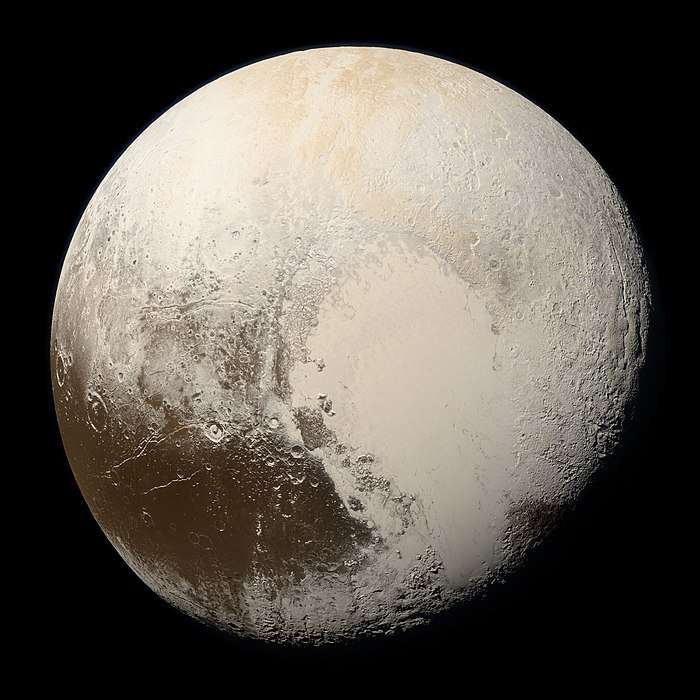Eris (dwarf planet)
Eris (minor planet designation 136199 Eris) is the most massive[19] and second-largest known dwarf planet in the Solar System. Eris was discovered in January 2005 by a Palomar Observatory-based team led by Mike Brown, and its discovery was verified later that year. In September 2006 it was named after the goddess of strife and discord. Eris is the ninth-most massive object directly orbiting the Sun, and the sixteenth-most massive overall (including moons). It is also the largest object that has not been visited by a spacecraft. Eris has been measured at 2,326 ± 12 kilometers (1,445.3 ± 7.5 mi) in diameter.[10] Its mass is 0.27% as much as the Earth's and 27% more than dwarf planet Pluto's,[12][20] though Pluto is slightly larger by volume.[21]
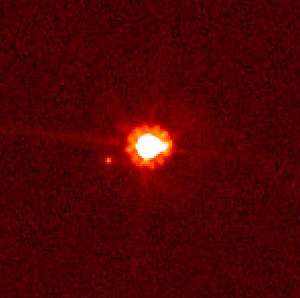 Eris (center) and Dysnomia (left of center), taken by the Hubble Space Telescope | |||||||||
| Discovery | |||||||||
|---|---|---|---|---|---|---|---|---|---|
| Discovered by | |||||||||
| Discovery date | January 5, 2005[2] | ||||||||
| Designations | |||||||||
| (136199) Eris | |||||||||
| Pronunciation | /ˈɪərɪs/[3] or /ˈɛrɪs/[4] | ||||||||
Named after | Ἔρις Eris | ||||||||
| 2003 UB313[5] Xena (nickname) | |||||||||
| Adjectives | Eridian /ɛˈrɪdiən/[8][9] | ||||||||
| Orbital characteristics[5] | |||||||||
| Epoch May 31, 2020 (JD 2459000.5) | |||||||||
| Earliest precovery date | September 3, 1954 | ||||||||
| Aphelion | 97.457 AU (14.579 Tm) | ||||||||
| Perihelion | 38.271 AU (5.725 Tm) | ||||||||
| 67.864 AU (10.152 Tm) | |||||||||
| Eccentricity | 0.43607 | ||||||||
| 559.07 yr (204,199 d) | |||||||||
Average orbital speed | 3.434 km/s | ||||||||
| 205.989° | |||||||||
| Inclination | 44.040° | ||||||||
| 35.951° | |||||||||
| 151.639° | |||||||||
| Known satellites | Dysnomia | ||||||||
| Physical characteristics | |||||||||
Mean diameter | 2326±12 km | ||||||||
Mean radius | 1163±6 km[10][11] | ||||||||
| (1.70±0.02)×107 km2[lower-alpha 1] | |||||||||
| Volume | (6.59±0.10)×109 km3[lower-alpha 1] | ||||||||
| Mass | |||||||||
Mean density | 2.52±0.07 g/cm3[lower-alpha 2] | ||||||||
Equatorial surface gravity | 0.82±0.02 m/s2 0.083±0.002 g[lower-alpha 3] | ||||||||
Equatorial escape velocity | 1.38 ± 0.01 km/s[lower-alpha 3] | ||||||||
Sidereal rotation period | ≈ 25.92 hr[13] ≈ 28.03 hr[14] | ||||||||
| 0.96+0.09 −0.04 [sic][10] | |||||||||
| |||||||||
| B−V=0.78, V−R=0.45[15] | |||||||||
| 18.7[16] | |||||||||
| −1.17+0.06 −0.11[lower-alpha 4] | |||||||||
| 34.4±1.4 milli-arcsec[18] | |||||||||
Eris is a trans-Neptunian object (TNO) and a member of a high-eccentricity population known as the scattered disk. It has one known moon, Dysnomia. As of February 2016, its distance from the Sun was 96.3 astronomical units (1.441×1010 km; 8.95×109 mi),[16] roughly three times that of Pluto. With the exception of some long-period comets, until 2018 VG18 was discovered on December 17, 2018, Eris and Dysnomia were the most distant known natural objects in the Solar System.[16]
Because Eris appeared to be larger than Pluto, NASA initially described it as the Solar System's tenth planet. This, along with the prospect of other objects of similar size being discovered in the future, motivated the International Astronomical Union (IAU) to define the term planet for the first time. Under the IAU definition approved on August 24, 2006, Eris is a "dwarf planet", along with objects such as Pluto, Ceres, Haumea and Makemake,[22] thereby reducing the number of known planets in the Solar System to eight, the same as before Pluto's discovery in 1930. Observations of a stellar occultation by Eris in 2010 showed that its diameter was 2,326 ± 12 kilometers (1,445.3 ± 7.5 mi), very slightly less than Pluto,[23][24] which was measured by New Horizons as 2,376.6 ± 3.6 kilometers (1,476.8 ± 2.2 mi) in July 2015.[25][26]
Discovery
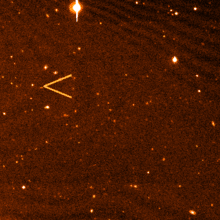
Eris was discovered by the team of Mike Brown, Chad Trujillo, and David Rabinowitz[2] on January 5, 2005, from images taken on October 21, 2003.[27] The discovery was announced on July 29, 2005, the same day as Makemake and two days after Haumea,[28] due in part to events that would later lead to controversy about Haumea. The search team had been systematically scanning for large outer Solar System bodies for several years, and had been involved in the discovery of several other large TNOs, including 50000 Quaoar, 90482 Orcus, and 90377 Sedna.[29]
Routine observations were taken by the team on October 21, 2003, using the 1.2 m Samuel Oschin Schmidt telescope at Palomar Observatory, California, but the image of Eris was not discovered at that point due to its very slow motion across the sky: The team's automatic image-searching software excluded all objects moving at less than 1.5 arcseconds per hour to reduce the number of false positives returned.[27] When Sedna was discovered in 2003, it was moving at 1.75 arcsec/h, and in light of that the team reanalyzed their old data with a lower limit on the angular motion, sorting through the previously excluded images by eye. In January 2005, the re-analysis revealed Eris's slow motion against the background stars.[27]
Follow-up observations were then carried out to make a preliminary determination of Eris's orbit, which allowed the object's distance to be estimated.[27] The team had planned to delay announcing their discoveries of the bright objects Eris and Makemake until further observations and calculations were complete, but announced them both on July 29 when the discovery of another large TNO they had been tracking, Haumea, was controversially announced on July 27 by a different team in Spain.[2]
Precovery images of Eris have been identified back to September 3, 1954.[5]
More observations released in October 2005 revealed that Eris has a moon, later named Dysnomia. Observations of Dysnomia's orbit permitted scientists to determine the mass of Eris, which in June 2007 they calculated to be (1.66±0.02)×1022 kg,[12] 27%±2% greater than Pluto's.
Name
Eris is named after the Greek goddess Eris (Greek Ἔρις), a personification of strife and discord.[30] The name was proposed by the Caltech Team on September 6, 2006, and it was assigned on September 13, 2006,[31] following an unusually long period in which the object was known by the provisional designation 2003 UB313, which was granted automatically by the IAU under their naming protocols for minor planets.
Like the moons Io and Mimas, and for the same reason, the name Eris has two competing pronunciations, with a 'long' and a 'short' e.[32] The literary English pronunciation of the goddess is /ˈɪərɪs/ with a long e.[3] However, Brown and his students[33] use something closer to Latin and Greek, /ˈɛrɪs/ with a short e (ignoring the Great Vowel Shift that affects Classical names in English).[4]
The Greek and Latin oblique stem of the name is Erid-,[34] as can be seen in Italian Eride and Russian Эрида Erida, so the adjective in English is Eridian /ɛˈrɪdiən/.[8][9]
Xena
Due to uncertainty over whether the object would be classified as a planet or a minor planet, because different nomenclature procedures apply to these different classes of objects,[35] the decision on what to name the object had to wait until after the August 24, 2006 IAU ruling.[36] As a result, for a time the object became known to the wider public as Xena.
"Xena" was an informal name used internally by the discovery team. It was inspired by the title character of the television series Xena: Warrior Princess. The discovery team had reportedly saved the nickname "Xena" for the first body they discovered that was larger than Pluto. According to Brown,
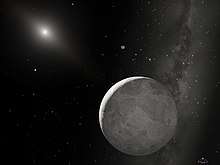
We chose it since it started with an X (planet "X"), it sounds mythological (OK, so it's TV mythology, but Pluto is named after a cartoon, right?),[lower-alpha 5] and (this part is actually true) we've been working to get more female deities out there (e.g. Sedna). Also, at the time, the TV show was still on TV, which shows you how long we've been searching![38]
"We assumed [that] a real name would come out fairly quickly, [but] the process got stalled", Mike Brown said in an interview:
One reporter [Ken Chang][39] called me up from The New York Times who happened to have been a friend of mine from college, [and] I was a little less guarded with him than I am with the normal press. He asked me, "What's the name you guys proposed?" and I said, "Well, I'm not going to tell." And he said, "Well, what do you guys call it when you're just talking amongst yourselves?" ... As far as I remember this was the only time I told anybody this in the press, and then it got everywhere, which I only sorta felt bad about—I kinda like the name.[40]
Choosing an official name
According to science writer Govert Schilling, Brown initially wanted to call the object "Lila", after a concept in Hindu mythology that described the cosmos as the outcome of a game played by Brahman.[29] The name was very similar to "Lilah", the name of Brown's newborn daughter. Brown was mindful of not making his name public before it had been officially accepted. He had done so with Sedna a year previously, and had been heavily criticized. However, no objection was raised to the Sedna name other than the breach of protocol, and no competing names were suggested for Sedna.[41]
He listed the address of his personal web page announcing the discovery as /~mbrown/planetlila and in the chaos following the controversy over the discovery of Haumea, forgot to change it. Rather than needlessly anger more of his fellow astronomers, he simply said that the webpage had been named for his daughter and dropped "Lila" from consideration.[29]
Brown had also speculated that Persephone, the wife of the god Pluto, would be a good name for the object.[2] The name had been used several times in science fiction,[42] and was popular with the public, having handily won a poll conducted by New Scientist magazine ("Xena", despite only being a nickname, came fourth).[43] This was not possible once the object was classified as a dwarf planet, because there is already an asteroid with that name, 399 Persephone.[2]
With the dispute resolved, the discovery team proposed Eris on September 6, 2006. On September 13, 2006 this name was accepted as the official name by the IAU.[44][45] Brown decided that, because the object had been considered a planet for so long, it deserved a name from Greek or Roman mythology, like the other planets. The asteroids had taken the vast majority of Graeco-Roman names. Eris, whom Brown described as his favorite goddess, had fortunately escaped inclusion.[40] "Eris caused strife and discord by causing quarrels among people", said Brown in 2006, "and that's what this one has done too".[46]
Classification
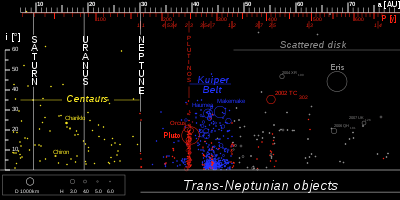
Eris is a trans-Neptunian dwarf planet (plutoid).[47] Its orbital characteristics more specifically categorize it as a scattered-disk object (SDO), or a TNO that has been "scattered" from the Kuiper belt into more-distant and unusual orbits following gravitational interactions with Neptune as the Solar System was forming. Although its high orbital inclination is unusual among the known SDOs, theoretical models suggest that objects that were originally near the inner edge of the Kuiper belt were scattered into orbits with higher inclinations than objects from the outer belt.[48]
Because Eris was initially thought to be larger than Pluto, it was described as the "tenth planet" by NASA and in media reports of its discovery.[49] In response to the uncertainty over its status, and because of ongoing debate over whether Pluto should be classified as a planet, the IAU delegated a group of astronomers to develop a sufficiently precise definition of the term planet to decide the issue. This was announced as the IAU's Definition of a Planet in the Solar System, adopted on August 24, 2006. At this time, both Eris and Pluto were classified as dwarf planets, a category distinct from the new definition of planet.[50] Brown has since stated his approval of this classification.[51] The IAU subsequently added Eris to its Minor Planet Catalogue, designating it (136199) Eris.[36]
Orbit
Eris has an orbital period of 559 years.[16] Its maximum possible distance from the Sun (aphelion) is 97.65 AU, and its closest (perihelion) is 37.91 AU.[16] It came to perihelion between 1698[7] and 1699,[52] to aphelion around 1977,[52] and will return to perihelion around 2256[52] to 2258.[53] Unlike the eight planets, whose orbits all lie roughly in the same plane as the Earth's, Eris's orbit is highly inclined: It is tilted at an angle of about 44 degrees to the ecliptic.[5] When discovered, Eris and its moon were the most distant known objects in the Solar System, apart from long-period comets and space probes.[2][54] It retained this distinction until the discovery of 2018 VG18 in 2018.[55]
As of 2008 there were approximately forty known TNOs, most notably 2006 SQ372, 2000 OO67 and Sedna, that are currently closer to the Sun than Eris even though their semimajor axis is larger than that of Eris (67.8 AU).[6]
Eris's orbit is highly eccentric, and brings Eris to within 37.9 AU of the Sun, a typical perihelion for scattered objects.[56] This is within the orbit of Pluto, but still safe from direct interaction with Neptune (~37 AU).[57] Pluto, on the other hand, like other plutinos, follows a less inclined and less eccentric orbit and, protected by orbital resonance, can cross Neptune's orbit.[58] In about 800 years, Eris will be closer to the Sun than Pluto for some time (see the graph at the left).
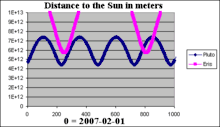
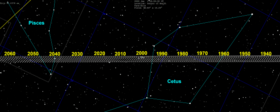
As of 2007, Eris has an apparent magnitude of 18.7, making it bright enough to be detectable to some amateur telescopes.[59] A 200-millimeter (7.9 in) telescope with a CCD can detect Eris under favorable conditions.[lower-alpha 6] The reason it had not been noticed until now is its steep orbital inclination; searches for large outer Solar System objects tend to concentrate on the ecliptic plane, where most bodies are found.[60]
Because of the high inclination of its orbit, Eris passes through only a few constellations of the traditional Zodiac; it is now in the constellation Cetus. It was in Sculptor from 1876 until 1929 and Phoenix from roughly 1840 until 1875. In 2036 it will enter Pisces and stay there until 2065, when it will enter Aries.[52] It will then move into the northern sky, entering Perseus in 2128 and Camelopardalis (where it will reach its northernmost declination) in 2173.
Size, mass and density
| Year | Radius (diameter) | Source |
|---|---|---|
| 2005 | 1,199 (2,397) km[61] | Hubble |
| 2007 | 1,300 (2,600) km[62] | Spitzer |
| 2011 | 1,163 (2,326) km[10] | Occultation |
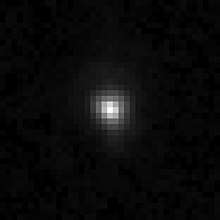
In November 2010, Eris was the subject of one of the most distant stellar occultations yet from Earth.[11] Preliminary data from this event cast doubt on previous size estimates.[11] The teams announced their final results from the occultation in October 2011, with an estimated diameter of 2326±12 km.[10]
This makes Eris a little smaller than Pluto by area and diameter, which is 2372±4 km across, although Eris is more massive. It also indicates an albedo of 0.96, higher than that of any other large body in the Solar System except Enceladus.[10] It is speculated that the high albedo is due to the surface ices being replenished because of temperature fluctuations as Eris's eccentric orbit takes it closer and farther from the Sun.[18]
The mass of Eris can be calculated with much greater precision. Based on the currently accepted value for Dysnomia's period—15.774 days[12][63]—Eris is 27 percent more massive than Pluto. Using the 2011 occultation results, Eris has a density of 2.52±0.07 g/cm3,[lower-alpha 2] substantially denser than Pluto, and thus must be composed largely of rocky materials.[10]
Models of internal heating via radioactive decay suggest that Eris could have an internal ocean of liquid water at the mantle–core boundary.[64]
In July 2015, after nearly ten years of Eris being considered the ninth-largest object known to directly orbit the sun, close-up imagery from the New Horizons mission more accurately determined Pluto's volume to be slightly larger than Eris's, rather than slightly smaller as previously thought.[65] Eris is now the tenth-largest object known to directly orbit the sun by volume, but remains the ninth-largest by mass.
Surface and atmosphere

The discovery team followed up their initial identification of Eris with spectroscopic observations made at the 8 m Gemini North Telescope in Hawaii on January 25, 2005. Infrared light from the object revealed the presence of methane ice, indicating that the surface may be similar to that of Pluto, which at the time was the only TNO known to have surface methane, and of Neptune's moon Triton, which also has methane on its surface.[66]
Due to Eris's distant eccentric orbit, its surface temperature is estimated to vary between about 30 and 56 K (−243.2 and −217.2 °C).[2]
Unlike the somewhat reddish Pluto and Triton, Eris appears almost white.[2] Pluto's reddish color is thought to be due to deposits of tholins on its surface, and where these deposits darken the surface, the lower albedo leads to higher temperatures and the evaporation of methane deposits. In contrast, Eris is far enough from the Sun that methane can condense onto its surface even where the albedo is low. The condensation of methane uniformly over the surface reduces any albedo contrasts and would cover up any deposits of red tholins.[27]
Even though Eris can be up to three times farther from the Sun than Pluto, it approaches close enough that some of the ices on the surface might warm enough to sublime. Because methane is highly volatile, its presence shows either that Eris has always resided in the distant reaches of the Solar System, where it is cold enough for methane ice to persist, or that the celestial body has an internal source of methane to replenish gas that escapes from its atmosphere. This contrasts with observations of another discovered TNO, Haumea, which reveal the presence of water ice but not methane.[67]
Satellite
In 2005, the adaptive optics team at the Keck telescopes in Hawaii carried out observations of the four brightest TNOs (Pluto, Makemake, Haumea, and Eris), using the newly commissioned laser guide star adaptive optics system.[69] Images taken on September 10 revealed a moon in orbit around Eris. In keeping with the "Xena" nickname already in use for Eris, Brown's team nicknamed the moon "Gabrielle", after the television warrior princess' sidekick. When Eris received its official name from the IAU, the moon received the name Dysnomia, after the Greek goddess of lawlessness who was Eris's daughter. Brown says he picked it for similarity to his wife's name, Diane. The name also retains an oblique reference to Eris's old informal name Xena, portrayed on TV by Lucy Lawless.[70]
Exploration
In the 2010s, on the heels of the successful Pluto flyby there were multiple studies for follow-on missions to explore the Kuiper belt, and Eris was evaluated among the candidates.[71] It was calculated that a flyby mission to Eris could take 24.66 years using a Jupiter gravity assist, based on launch dates of April 3, 2032 or April 7, 2044. Eris would be 92.03 or 90.19 AU from the Sun when the spacecraft arrives.[72]
See also
- Clearing the neighbourhood
- Former classification of planets
- List of Solar System objects most distant from the Sun in 2015
- List of trans-Neptunian objects
- Mesoplanet
Notes
- Calculated from the mean radius
- Calculated by dividing the listed mass by the listed volume
- Calculated based on the known parameters
- Calculated from the listed diameter (D) and albedo (p) using [17]
- Brown is joking at this point. It was in fact the Disney character Pluto that was named after the newly discovered planet, though Venetia Phair, Pluto's christener, had to counter accusations her whole life that she named the planet after a cartoon dog.[37]
- For an example of an amateur image of Eris, see Fred Bruenjes' Astronomy Archived November 2, 2005, at the Wayback Machine
References
- "Discovery Circumstances: Numbered Minor Planets". IAU: Minor Planet Center. May 1, 2007. Archived from the original on May 4, 2016. Retrieved May 5, 2007.
- Brown, Mike (2006). "The discovery of 2003 UB313 Eris, the largest known dwarf planet". Archived from the original on July 19, 2011. Retrieved May 3, 2007.
- Noah Webster (1884) A Practical Dictionary of the English Language
- "Eris". Lexico UK Dictionary. Oxford University Press.
"Eris". Merriam-Webster Dictionary. - "JPL Small-Body Database Browser: 136199 Eris (2003 UB313)" (December 14, 2019 solution date). Archived from the original on April 12, 2016. Retrieved February 20, 2020.
- "List Of Centaurs and Scattered-Disk Objects". Minor Planet Center. Archived from the original on July 25, 2011. Retrieved September 10, 2008.
- Buie, Marc (November 6, 2007). "Orbit Fit and Astrometric record for 136199". Deep Ecliptic Survey. Archived from the original on July 15, 2012. Retrieved December 8, 2007.
- David Morrison (2008) Ask an Astrobiologist Archived 2009-04-25 at the Wayback Machine
- Ian Douglas (2013) Semper Human
- Sicardy, B.; Ortiz, J. L.; Assafin, M.; Jehin, E.; Maury, A.; Lellouch, E.; Gil-Hutton, R.; Braga-Ribas, F.; Colas, F.; Widemann (2011). "Size, density, albedo and atmosphere limit of dwarf planet Eris from a stellar occultation" (PDF). European Planetary Science Congress Abstracts. 6: 137. Bibcode:2011epsc.conf..137S. Archived (PDF) from the original on October 18, 2011. Retrieved September 14, 2011.
- Beatty, Kelly (November 2010). "Former 'tenth planet' may be smaller than Pluto". NewScientist.com. Sky and Telescope. Archived from the original on February 23, 2012. Retrieved October 17, 2011.
- Brown, Michael E.; Schaller, Emily L. (June 15, 2007). "The Mass of Dwarf Planet Eris" (PDF). Science. 316 (5831): 1585. Bibcode:2007Sci...316.1585B. doi:10.1126/science.1139415. PMID 17569855. Archived from the original (PDF) on March 4, 2016. Retrieved September 27, 2015.CS1 maint: ref=harv (link)
- Roe, Henry G.; Pike, Rosemary E.; Brown, Michael E. (December 2008). "Tentative detection of the rotation of Eris". Icarus. 198 (2): 459–464. arXiv:0808.4130. Bibcode:2008Icar..198..459R. doi:10.1016/j.icarus.2008.08.001.
- Duffard, R.; Ortiz, J. L.; Santos Sanz, P.; Mora, A.; Gutiérrez, P. J.; Morales, N.; Guirado, D. (March 2008). "A study of photometric variations on the dwarf planet (136199) Eris" (PDF). Astronomy & Astrophysics. 479 (3): 877–881. Bibcode:2008A&A...479..877D. doi:10.1051/0004-6361:20078619. Retrieved December 26, 2019.
- Snodgrass, C.; Carry, B.; Dumas, C.; Hainaut, O. (February 2010). "Characterisation of candidate members of (136108) Haumea's family". Astronomy and Astrophysics. 511: A72. arXiv:0912.3171. Bibcode:2010A&A...511A..72S. doi:10.1051/0004-6361/200913031.CS1 maint: ref=harv (link)
- "AstDys (136199) Eris Ephemerides". Department of Mathematics, University of Pisa, Italy. Retrieved February 28, 2016.
- "Conversion of Absolute Magnitude to Diameter". sfasu.edu. Archived from the original on March 23, 2010.
- M. E. Brown; E.L. Schaller; H.G. Roe; D. L. Rabinowitz; C. A. Trujillo (2006). "Direct measurement of the size of 2003 UB313 from the Hubble Space Telescope" (PDF). The Astrophysical Journal. 643 (2): L61–L63. arXiv:astro-ph/0604245. Bibcode:2006ApJ...643L..61B. CiteSeerX 10.1.1.256.601. doi:10.1086/504843. Archived (PDF) from the original on September 10, 2008. Retrieved April 11, 2006.
- Sengupta, Sujan (2015). Worlds Beyond Our Own: The Search for Habitable Planets. Switzerland: Springer International Publishing. p. 49. ISBN 978-3-319-09893-7.
- "Dwarf Planet Outweighs Pluto". space.com. 2007. Archived from the original on June 17, 2007. Retrieved June 14, 2007.
- "How Big Is Pluto? New Horizons Settles Decades-Long Debate". www.nasa.gov. 2015. Archived from the original on July 1, 2017. Retrieved July 14, 2015.
- "The IAU draft definition of "planet" and "plutons"" (Press release). IAU. August 16, 2006. Archived from the original on August 20, 2006. Retrieved August 16, 2006.
- Brown, Mike (2010). "The shadowy hand of Eris". Mike Brown's Planets. Archived from the original on November 11, 2010. Retrieved November 7, 2010.
- Brown, Mike (November 22, 2010). "How big is Pluto, anyway?". Mike Brown's Planets. Archived from the original on July 21, 2011. Retrieved November 23, 2010. (Franck Marchis on 2010-11-08)
- "How Big Is Pluto? New Horizons Settles Decades-Long Debate". NASA. 2015. Archived from the original on July 13, 2015. Retrieved July 13, 2015.
- Stern, S. A.; Grundy, W.; McKinnon, W. B.; Weaver, H. A.; Young, L. A. (2017). "The Pluto System After New Horizons". Annual Review of Astronomy and Astrophysics. 2018: 357–392. arXiv:1712.05669. Bibcode:2018ARA&A..56..357S. doi:10.1146/annurev-astro-081817-051935.
- M. E. Brown; C. A. Trujillo; D. L. Rabinowitz (2005). "Discovery of a Planetary-sized Object in the Scattered Kuiper Belt". The Astrophysical Journal. 635 (1): L97–L100. arXiv:astro-ph/0508633. Bibcode:2005ApJ...635L..97B. doi:10.1086/499336.
- Thomas H. Maugh II; John Johnson Jr. (October 16, 2005). "His Stellar Discovery Is Eclipsed". Los Angeles Times. Archived from the original on October 12, 2012. Retrieved July 14, 2008.
- Schilling, Govert (2008). The Hunt For Planet X. Springer. p. 214. ISBN 978-0-387-77804-4.
- Blue, Jennifer (September 14, 2006). "2003 UB 313 named Eris". USGS Astrogeology Research Program. Archived from the original on October 18, 2006. Retrieved January 3, 2007.
- Brown, Mike. "New Planet". web.gps.caltech.edu. Archived from the original on May 20, 2012. Retrieved January 5, 2010.
- "Eris". Dictionary.com Unabridged. Random House.
- "Julia Sweeney and Michael E. Brown". Hammer Conversations: KCET podcast. 2007. Archived from the original on October 6, 2008. Retrieved October 1, 2008.
- Eris. Charlton T. Lewis and Charles Short. A Latin Dictionary on Perseus Project.
- "International Astronomical Association homepage". Archived from the original on September 30, 2007. Retrieved January 5, 2007.
- Green, Daniel W. E. (September 13, 2006). "(134340) Pluto, (136199) Eris, and (136199) Eris I (Dysnomia)" (PDF). IAU Circular. 8747: 1. Bibcode:2006IAUC.8747....1G. Archived from the original on February 5, 2007. Retrieved January 12, 2012.
- "The girl who named a planet". BBC News. January 13, 2006. Archived from the original on August 20, 2011. Retrieved June 21, 2007.
- "Xena and Gabrielle" (PDF). Status. January 2006. Archived from the original (PDF) on March 14, 2012. Retrieved May 3, 2007.
- Mike Brown (2012). How I Killed Pluto and Why It Had It Coming. Spiegel & Grau. p. 159.
- Brown, Mike (2007). "Lowell Lectures in Astronomy". WGBH. Archived from the original on July 16, 2008. Retrieved July 13, 2008.
- "Mpc 52733" (PDF). Minor Planet Center. 2004. Archived (PDF) from the original on July 25, 2011. Retrieved August 30, 2010.
- "Planet X Marks the Spot" (PDF). TechRepublic. 2006. Archived (PDF) from the original on September 10, 2008. Retrieved July 13, 2008.
- O'Neill, Sean (2005). "Your top 10 names for the tenth planet". NewScientist. Archived from the original on May 1, 2008. Retrieved June 28, 2008.
- "The Discovery of Eris, the Largest Known Dwarf Planet". California Institute of Technology, Department of Geological Sciences. Archived from the original on July 19, 2011. Retrieved January 5, 2007.
- "IAU0605: IAU Names Dwarf Planet Eris". International Astronomical Union News. September 14, 2006. Archived from the original on January 4, 2007. Retrieved January 5, 2007.
- Andy Sullivan (2006). "Xena renamed Eris in planet shuffle". Reuters. Retrieved January 29, 2020.
- "Pluto Now Called a Plutoid". Space.com. June 11, 2008. Archived from the original on June 12, 2008. Retrieved June 11, 2008.
- Gomes R. S.; Gallardo T.; Fernández J. A.; Brunini A. (2005). "On the origin of the High-Perihelion Scattered Disk: the role of the Kozai mechanism and mean motion resonances". Celestial Mechanics and Dynamical Astronomy. 91 (1–2): 109–129. Bibcode:2005CeMDA..91..109G. doi:10.1007/s10569-004-4623-y.
- "NASA-Funded Scientists Discover Tenth Planet". Jet Propulsion Laboratory. 2005. Archived from the original on May 14, 2007. Retrieved May 3, 2007.
- "IAU 2006 General Assembly: Resolutions 5 and 6" (PDF). IAU. August 24, 2006. Archived from the original (PDF) on September 28, 2006.
- Robert Roy Britt (2006). "Pluto Demoted: No Longer a Planet in Highly Controversial Definition". space.com. Archived from the original on December 27, 2010. Retrieved May 3, 2007.
- Yeomans, Donald K. "Horizons Online Ephemeris System". California Institute of Technology, Jet Propulsion Laboratory. Archived from the original on June 6, 2012. Retrieved January 5, 2007.
- Johnston, Wm. Robert (September 20, 2014). "(136199) Eris and Dysnomia". Johnston's Archive. Archived from the original on April 28, 2014. Retrieved September 27, 2015.
- Peat, Chris. "Spacecraft escaping the Solar System". Heavens-Above. Archived from the original on May 11, 2018. Retrieved January 25, 2008.
- "Discovered: The Most-Distant Solar System Object Ever Observed". Carnegie Science. December 17, 2018. Archived from the original on December 17, 2018. Retrieved December 18, 2018.
The second-most-distant observed Solar System object is Eris, at about 96 AU.
- Trujillo, Chadwick A.; Jewitt, David C.; Luu, Jane X. (February 1, 2000). "Population of the Scattered Kuiper Belt" (PDF). The Astrophysical Journal. 529 (2): L103–L106. arXiv:astro-ph/9912428. Bibcode:2000ApJ...529L.103T. CiteSeerX 10.1.1.338.2682. doi:10.1086/312467. PMID 10622765. Archived from the original (PDF) on August 12, 2007. Retrieved July 2, 2008.
- Patryk Sofia Lykawka, Tadashi Mukai (July 2007). "Dynamical classification of trans-neptunian objects: Probing their origin, evolution, and interrelation". Icarus. 189 (1): 213–232. Bibcode:2007Icar..189..213L. doi:10.1016/j.icarus.2007.01.001.
- David Jewitt. "The Plutinos". UCLA. Retrieved January 29, 2020.
- H.-W.Lin; Y.-L.Wu; W.-H.Ip (2007). "Observations of dwarf planet (136199) Eris and other large TNOs on Lulin Observatory". Advances in Space Research. 40 (2): 238–243. Bibcode:2007AdSpR..40..238L. doi:10.1016/j.asr.2007.06.009.CS1 maint: multiple names: authors list (link)
- "Bye-Bye Planet Pluto". Horizon. June 22, 2006. BBC.
- "Hubble Finds 'Tenth Planet' Slightly Larger Than Pluto". NASA. April 11, 2006. Archived from the original on August 29, 2008. Retrieved August 29, 2008.
- John Stansberry; Will Grundy; Mike Brown; John Spencer; David Trilling; Dale Cruikshank; Jean-Luc Margot (2007). Physical Properties of Kuiper Belt and Centaur Objects: Constraints from Spitzer Space Telescope. arXiv:astro-ph/0702538. Bibcode:2008ssbn.book..161S.
- Brown, Mike (2007). "Dysnomia, the moon of Eris". Caltech. Archived from the original on October 3, 2012. Retrieved June 14, 2007.
- Hussmann, Hauke; Sohl, Frank; Spohn, Tilman (November 2006). "Subsurface oceans and deep interiors of medium-sized outer planet satellites and large trans-neptunian objects". Icarus. 185 (1): 258–273. Bibcode:2006Icar..185..258H. doi:10.1016/j.icarus.2006.06.005. Archived (PDF) from the original on August 31, 2015. Retrieved December 2, 2017.
- "New Horizons Probe Finds Out Pluto's Bigger (and Icier) Than We Thought". NBC News. July 13, 2015. Archived from the original on July 13, 2015. Retrieved July 13, 2015.
- "Gemini Observatory Shows That "10th Planet" Has a Pluto-Like Surface". Gemini Observatory. 2005. Archived from the original on March 11, 2007. Retrieved May 3, 2007.
- J. Licandro; W. M. Grundy; N. Pinilla-Alonso; P. Leisy (2006). "Visible spectroscopy of 2003 UB313: evidence for N2 ice on the surface of the largest TNO" (PDF). Astronomy and Astrophysics. 458 (1): L5–L8. arXiv:astro-ph/0608044. Bibcode:2006A&A...458L...5L. doi:10.1051/0004-6361:20066028. Archived (PDF) from the original on November 21, 2008. Retrieved November 14, 2006.
- "Faraway Eris is Pluto's Twin". ESO Science Release. October 26, 2011. Archived from the original on October 28, 2011. Retrieved October 28, 2011.
- Brown, M. E.; Van Dam, M. A.; Bouchez, A. H.; Le Mignant, D.; Campbell, R. D.; Chin, J. C. Y.; Conrad, A.; Hartman, S. K.; Johansson, E. M.; Lafon, R. E.; Rabinowitz, D. L. Rabinowitz; Stomski, P. J., Jr.; Summers, D. M.; Trujillo, C. A.; Wizinowich, P. L. (2006). "Satellites of the Largest Kuiper Belt Objects" (PDF). The Astrophysical Journal. 639 (1): L43–L46. arXiv:astro-ph/0510029. Bibcode:2006ApJ...639L..43B. doi:10.1086/501524. Archived (PDF) from the original on November 3, 2013. Retrieved October 19, 2011.
- Tytell, David (2006). "All Hail Eris and Dysnomia". Sky and Telescope. Archived from the original on December 27, 2014. Retrieved January 5, 2010.
- "SwRI team makes breakthroughs studying Pluto orbiter mission". Astrobiology Magazine. October 25, 2018. Retrieved October 27, 2018.
- McGranaghan, R.; Sagan, B.; Dove, G.; Tullos, A.; Lyne, J. E.; Emery, J. P. (2011). "A Survey of Mission Opportunities to Trans-Neptunian Objects". Journal of the British Interplanetary Society. 64: 296–303. Bibcode:2011JBIS...64..296M.
External links
- Michael Brown's webpages about Eris and Dysnomia
- MPC Database entry for (136199) Eris
- compiled list of data
- Java 3D orbit visualization
- Spaceflight Now article about 2003 UB313 (Eris), 2003 EL61, and 2005 FY9 (Makemake)
- Slacker Astronomy Interview With Co-Discoverer Trujillo
- Simulation of 2003 UB313's orbit
- Keck observatory page about the discovery of Dysnomia
- Eris (dwarf planet) at AstDyS-2, Asteroids—Dynamic Site
- Eris at the JPL Small-Body Database

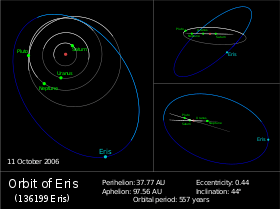

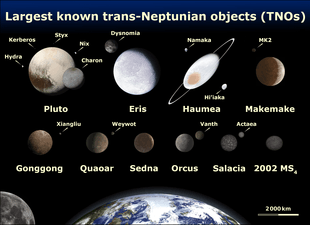
_(cropped).jpg)
